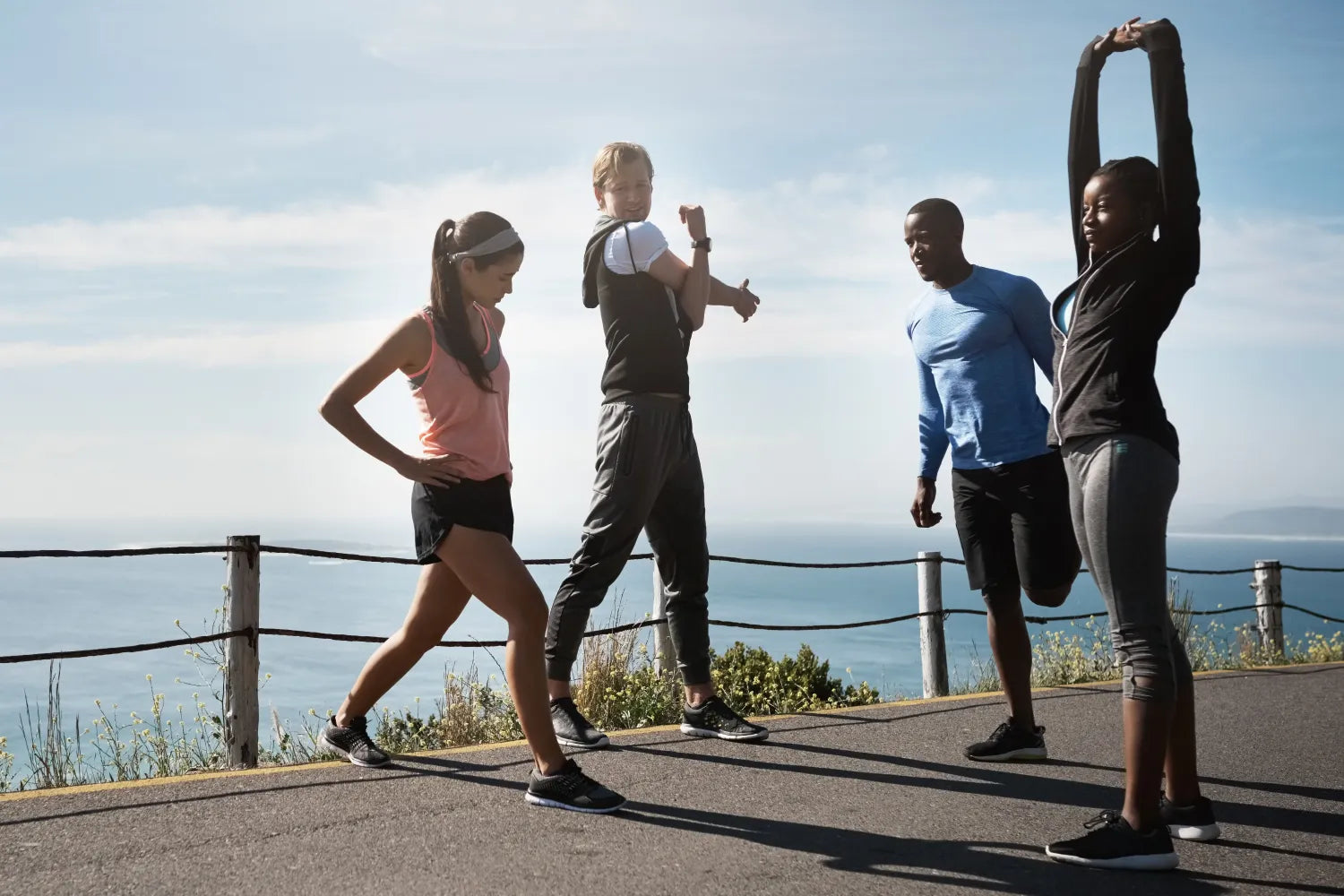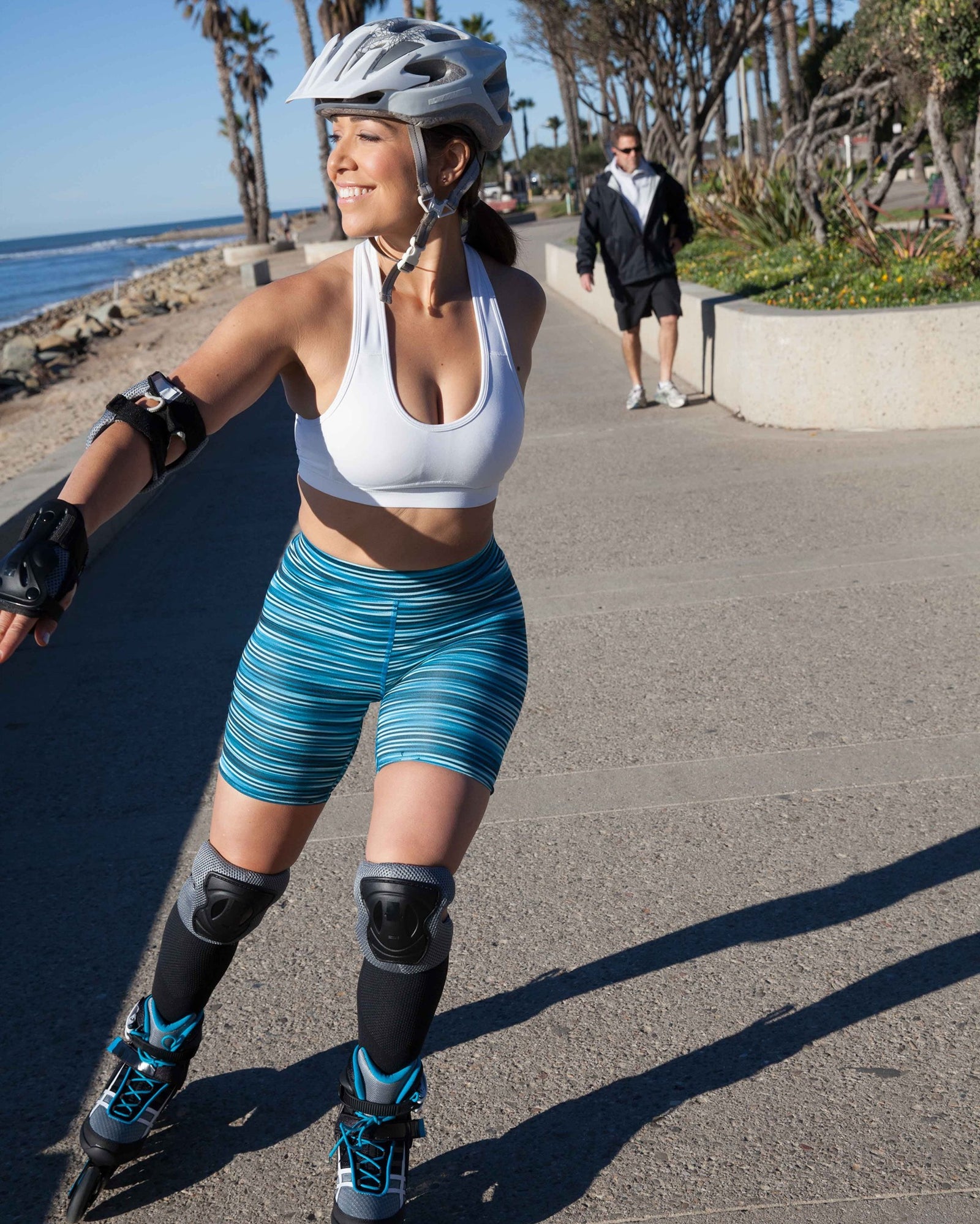
Key Takeaways
- Dynamic stretching before a run helps activate key muscle groups, such as glutes, hamstrings, and hip flexors, supporting smoother movement and reducing post-run discomfort.
- A quick 10-minute warm-up routine with controlled, movement-based exercises prepares your body for activity and helps support recovery afterward.
- Compression gear can be a helpful part of your warm-up and recovery routine, supporting circulation, joint stability, and overall muscle awareness before and after your run.
If you're gearing up for a run, whether you're training for your first 5K or heading out for a casual jog, what you do before you hit the pavement matters. A proper warm-up helps prepare your muscles for action, supports smoother movement, and sets the tone for better performance. Knowing how to warm up the right way can make all the difference in how you feel during and after your run.
Let’s break down what you really need to know: why warming up is essential, how to do it effectively, and how to make it part of your running routine. These practical tips are designed to help you move better, recover smarter, and enjoy every mile with more confidence.
Why Is Warming Up Important?
When you go from rest to movement too quickly, your muscles and joints don’t have time to adjust. That can lead to extra tension, inefficient movement, and a sluggish start.
A good warm-up supports healthy blood flow to your muscles, gradually raises your heart rate, and helps prep your nervous system for activity. You’ll feel more alert, mobile, and in control of your stride from the very beginning.
7 Tips To Help You Get Warmed Up for Your Run
Incorporating a pre-run warm-up into your routine helps keep you feeling and performing your best.
Let’s dive feet-first into ways to get the most out of your warm-up.
1. Prioritize Dynamic Stretches
Dynamic stretching includes movement-based stretches that actively take your muscles and joints through a full range of motion. This type of stretching is ideal before a run. Think walking lunges, leg swings, and high knees.
Static stretching, where you hold a stretch for 20 to 30 seconds (like touching your toes or pulling your heel to your glutes), is better saved for afteryour run. That’s when your muscles are warm and more receptive to lengthening. Some research suggests that static stretches beforehand may actually reduce your power output and make you feel less stable.
If you’ve always started your workout with static stretches, this might feel like a shift, but it’s a worthwhile one. Dynamic stretching helps wake up your muscle groups while promoting coordination and stability.
2. Focus on the Muscle Groups That Matter for Running
Running engages your entire body, but certain muscles do more of the heavy lifting. When you warm up, target the areas most involved in forward movement and balance:
- Hamstrings and quads: Power your stride and help with knee control
- Glutes: Support hip extension and stabilize the pelvis
- Hip flexors: Control leg swing and knee lift
- Calves and ankles: Propel you forward and absorb impact
- Core: Supports posture and helps transfer force through your body
Prepping these areas through dynamic movements helps encourage smoother, more coordinated motion and helps support joint stability along the way.
3. Include Light Cardio
Before you hit your stride, take a few minutes for light cardio, like brisk walking or an easy jog. This helps gradually increase your heart rate and supports blood flow to the muscles, which prepares them for more intense movement.
A little light cardio is especially important if you’re gearing up for a speed workout. Going from zero to sprint can place extra strain on cold muscles. A five-minute jog acts as a bridge between rest and effort, helping your muscles warm up naturally and respond more efficiently to faster paces.
4. Don’t Leave Out Your Core
Your core plays a major role in running, even if you don’t always feel it working. A strong, engaged core helps stabilize your posture, support efficient stride mechanics, and reduce the strain on your hips and lower back.
As part of your warm-up routine, include core-focused exercises like standing knee lifts, walking planks, or slow mountain climbers to activate the muscles that help keep you strong and steady from start to finish.
Keep your core engaged during your run, too. During your run, try gently bracing your abdominal muscles like you’re zipping up a tight jacket. You should still be able to breathe comfortably. This will help you maintain proper form and ease pressure on the back.
5. Time It Right
So how long should a warm-up take? Anywhere from five to 10 minutes is usually enough for most runners.
If you're running in cold weather or doing higher-intensity training (like intervals or hills), go closer to 10 to 15 minutes. If you're sore from a previous workout or coming off a long day of sitting, take more time to ease your body into motion. Listen to how your muscles feel and aim to move until you feel ready, not rushed.
6. Match Your Warm-Up to Your Workout
The more intense your run, the more focused your warm-up should be. If you’re planning hill repeats, interval training, or a tempo run, spend extra time getting your body primed. Go deeper into your dynamic stretches and extend your warm-up to 10 to 15 minutes.
Target the muscles you’ll rely on most during the session, including your glutes, quads, calves, and hamstrings, and make sure they feel activated, not tight. A more thorough warm-up can help you feel more powerful during challenging workouts and may reduce post-run discomfort.
7. Use Compression Gear
Compression gear can be a helpful part of your warm-up and recovery strategy. Compression socks and sleeves are designed to provide gentle, targeted pressure to key muscle groups. That compression can help support healthy blood flow during your warm-up, making it easier to get your muscles activated and ready for movement.
Wearing compression gear during activity can also support joint stability and muscle awareness. Copper Fit compression gear even includes menthol-infused and moisture-wicking fabric, which may add cooling sensations or reduce distractions during movement.
After your run, keeping compression gear on for a short time can help promote muscle relaxation and soothe discomfort. It’s one of those small, science-backed ways to support the body’s natural recovery process.
Watch Out for Common Warm-Up Mistakes
Even experienced runners sometimes skip warm-ups or rush through them. Here are a few missteps to avoid:
- Skipping the warm-up entirely because you're short on time
- Doing only static stretches before moving
- Going too fast through dynamic moves without control
- Ignoring the upper body, which helps with posture and momentum
- Forgetting to breathe; your breath helps support movement and focus
Make your warm-up a non-negotiable part of your routine. It’s a few minutes well spent, and your body will thank you during the run and afterward.
Try This Dynamic Warm-Up Routine
You don’t need a ton of time or space to get a solid warm-up in. Here’s a simple routine you can do before any run:
- Leg swings (front to back, side to side): 10 to 15 reps each leg
- Walking lunges with a twist: 10 steps forward, twisting gently toward the front knee
- High knees: 20 seconds, light bounce, keep posture tall
- Butt kicks: 20 seconds, quick and light
- Toy soldiers (straight-leg kicks): 10 to 15 per leg
- Arm circles and trunk rotations: 20 seconds each, relax your shoulders
During these dynamic stretches, move with intention and control, not speed. The goal is to activate and engage, not to fatigue. If your run is going to be intense, add a few light jogging strides at the end of your warm-up to help ease into it.
FAQs
How should I warm up before a run?
Start with five minutes of dynamic movement, such as leg swings, lunges with twists, high knees, and toy soldiers. Focus on activating the muscles you'll use most, such as the quads, glutes, calves, and core.
Is it better to stretch before or after running?
Before a run, use dynamic stretches to activate your muscles. Save static stretching (where you hold a position) for post-run, when your muscles are already warm and more receptive to lengthening.
What muscles should I warm up before running?
Focus on your quads, hamstrings, glutes, hip flexors, calves, and core—the muscle groups that drive and stabilize your stride.
The Bottom Line
At Copper Fit, we know how frustrating it is when your body doesn’t feel ready to move. You lace up, step outside, and your legs feel stiff, your stride feels awkward, or you’re fighting through that sluggish start. That’s why we believe in supporting the full picture: preparation, performance, and recovery.
Warming up is a powerful tool. It helps you move with more purpose, feel more stable, and get more out of every mile. Whether you’re walking, jogging, or chasing a new personal best, you deserve to feel strong and supported from start to finish.
We’re here to back you up with tools that support your muscles, promote healthy blood flow, and help soothe discomfort so you can stay in motion, every day.
Sources:
Dynamic Warm-ups Play Pivotal Role in Athletic Performance and Injury Prevention | ScienceDirect
Dynamic vs. Static Stretching | Cleveland Clinic
Core exercises: Why you should strengthen your core muscles | Mayo Clinic
Compression Clothing and Circulation Benefits | UPMC HealthBeat





